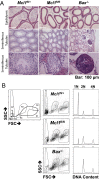Enhanced stability of Mcl1, a prosurvival Bcl2 relative, blunts stress-induced apoptosis, causes male sterility, and promotes tumorigenesis
- PMID: 24363325
- PMCID: PMC3890801
- DOI: 10.1073/pnas.1321259110
Enhanced stability of Mcl1, a prosurvival Bcl2 relative, blunts stress-induced apoptosis, causes male sterility, and promotes tumorigenesis
Abstract
The B-cell CLL/lymphoma 2 (Bcl2) relative Myeloid cell leukemia sequence 1 (Mcl1) is essential for cell survival during development and for tissue homeostasis throughout life. Unlike Bcl2, Mcl1 turns over rapidly, but the physiological significance of its turnover has been unclear. We have gained insight into the roles of Mcl1 turnover in vivo by analyzing mice harboring a modified allele of Mcl1 that serendipitously proved to encode an abnormally stabilized form of Mcl1 due to a 13-aa N-terminal extension. Although the mice developed normally and appeared unremarkable, the homozygous males unexpectedly proved infertile due to defective spermatogenesis, which was evoked by enhanced Mcl1 prosurvival activity. Under unstressed conditions, the modified Mcl1 is present at levels comparable to the native protein, but it is markedly stabilized in cells subjected to stresses, such as protein synthesis inhibition or UV irradiation. Strikingly, the modified Mcl1 allele could genetically complement the loss of Bcl2, because introduction of even a single allele significantly ameliorated the severe polycystic kidney disease and consequent runting caused by Bcl2 loss. Significantly, the development of c-MYC-induced acute myeloid leukemia was also accelerated in mice harboring that Mcl1 allele. Our collective findings reveal that, under certain circumstances, the N terminus of Mcl1 regulates its degradation; that some cell types require degradation of Mcl1 to induce apoptosis; and, most importantly, that rapid turnover of Mcl1 can serve as a tumor-suppressive mechanism.
Keywords: programmed cell death; protein turnover.
Conflict of interest statement
The authors declare no conflict of interest.
Figures




References
-
- Tait SW, Green DR. Mitochondria and cell death: Outer membrane permeabilization and beyond. Nat Rev Mol Cell Biol. 2010;11(9):621–632. - PubMed
-
- Veis DJ, Sorenson CM, Shutter JR, Korsmeyer SJ. Bcl-2-deficient mice demonstrate fulminant lymphoid apoptosis, polycystic kidneys, and hypopigmented hair. Cell. 1993;75(2):229–240. - PubMed
-
- Vaux DL, Cory S, Adams JM. Bcl-2 gene promotes haemopoietic cell survival and cooperates with c-myc to immortalize pre-B cells. Nature. 1988;335(6189):440–442. - PubMed
Publication types
MeSH terms
Substances
LinkOut - more resources
Full Text Sources
Other Literature Sources
Medical
Molecular Biology Databases

